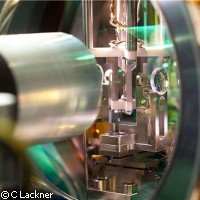Apr 15 2010
An EU-funded research team from Austria's University of Innsbruck has invented a single atom laser which works on the same principle as a classic laser but also has quantum mechanical properties in its atom-photon interactions. The results of the research, which are published in the journal Nature Physics, will lead to a better understanding of the properties of lasers and will be used for measuring trace gases and carbon isotope compositions in the air and soil.

EU support for the work came from the projects QUBITS ('Quantum based information processing and transfer using single atoms and photons'), and QUEST, both financed through the Fifth Framework Programme (FP5), and from the SCALA project ('Scalable quantum computing with light and atoms') which is funded under the Sixth Framework Programme (FP6). Additional funding came from the Federation of Austrian Industry Tirol and the Austrian Science Fund.
The first lasers (artificially produced electromagnetic light waves that can be manipulated by lenses), were developed only 50 years ago. Nowadays laser technology has now become a part of everyday life. It is widely used in many areas, especially electronics, medicine, industry, health and beauty, security and entertainment.
A classic laser consists of a gain medium (amplification device) inside a highly reflective optical cavity in which the light is amplified. In such a laser, there is a sharp increase in output power when a particular threshold is reached. At this point, the gain (amplification) equals the losses as the light circulates through the cavity. The higher the number of photons, the stronger is the amplification of the light.
The University of Innsbruck research team set out to demonstrate that a laser threshold can be achieved at the smallest possible building block of a laser, namely a single atom interacting with a single mode in an optical cavity. To do this, they confined a single calcium ion in an ion trap and excited it with external lasers. The optical cavity in the set-up consists of two mirrors that trap and accumulate the photons emitted by the ion into a mode. The ion is excited cyclically by an external laser and at each cycle a photon is added to the cavity mode which amplifies the light.
For strong atom-cavity coupling, the regime of atom and cavity shows quantum mechanical behaviour: only single photons can be introduced into the cavity. 'As a consequence, stimulated emission and threshold are absent,' explained the lead author of the study, François Dubin from the University of Innsbruck.
The latest research succeeds a similar study several years ago in which a quantum laser was demonstrated. The new research is different because coupling can be tuned to the cavity mode. The research team found that by choosing the right parameter of the drive laser, they were able to achieve stronger excitation and therefore add more photons to the cavity. Although there was still less than one photon in the cavity they were able to observe stimulated emission in the form of a threshold. 'A single atom is a very weak amplifier. As a consequence, the threshold is much less pronounced than in classical lasers,' said Dr Piet Schmidt from the University of Innsbruck.
In a classic laser, the stronger the excitation, the higher the output, but this is not the case in the University of Innsbruck's single atom laser. In their device, the output is quenched. The team intends to extend its research by investigating the transition between classical and quantum lasers through the controlled addition of more and more ions to interact with the light field.
Source: Cordis